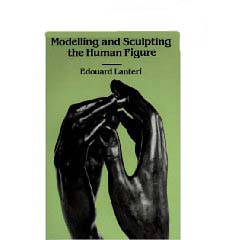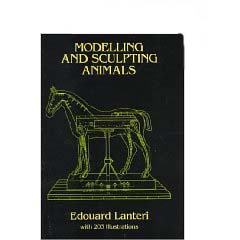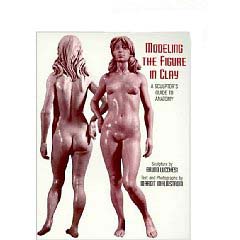From the Book Shelf of Sculptor Bridgette Mongeon
Created for Best of Artists and Artisans Website.
By Bridgette Mongeon © 2009
When apprentices enter the studio it’s not long before they gravitate to my bookshelves searching for resources on further education, or books that will inspire. I am quick to pull a couple of favorite sculpture books from my bookshelf and comment, “You must look at this book,” or “Every sculptor should have this on their shelf.” Though I never have enough art books and am always open to reviewing new books, I thought I would take some time to share with you a few of my favorites, those that I share with my students and apprentices.

Modeling and Sculpting the Human Figure by Edouard Lanteri
Amazon $10.17
It is my opinion that no sculpture studio should be without Modeling and Sculpting the Human Figure by Edouard Lanteri. The author, Edouard Lanteri was a British sculptor 1848-1917. “The book is a gold mine of technical information, the kind of reference work that should be a lifelong studio companion to the figure sculptor,” as described in the introduction by sculptor, Nathon Cabot Hale. The first of the Lanteri volumes was printed in 1911, my copy is a reprint with a copyright notice of 1965.
Using this book as a study guide will offer the sculpting student a wealth of information that would only be attained in many years of study. Modeling and Sculpting the Human Figure covers portrait busts, full figures, measurements, building of armatures, scales and proportions, poses, and much more. I have especially appreciated the section on draping cloth. We all know that muslin, velvet and silk look different, but how does a sculptor portray the material in clay? No beginning sculpting student or established studio should be without this book.

Modeling and Sculpting Animals by Eduard Lanteri
Amazon $11.65
Accompanying Lanteri’s book on Modeling and Sculpting the Human Figure is another book that was an original part of the 1911 edition—Modeling and Sculpting Animals. This book, with a forward written by friend and fellow sculptor Augusta Rodin covers what is in the Modeling and Sculpting the Human figure but in association with animals. Comparative measurements, construction, anatomy, armatures, and much more are featured with a bull, lion and horse as the subjects. Modeling and Sculpting the Human Animals is another book that should be on every sculptor’s shelf.

Modeling the figure in Clay by Brunno Luchessi
Amazon $14.93
For another self-taught study on the human form, a book that can’t be beat is Bruno Lucchesi’s Modeling the figure in Clay. In this book master sculptor Bruno Luchessi takes the artist through the entire process of creating a human form from skeleton to skin. Building the sculpture on a wire armature with bones, and then adding on the muscles and skin. I have often thought that this type of book and training would be of considerable importance to massage therapists as well. What better way to learn the anatomy and muscles of a client then to create the form from inside out in clay. A student wanting to hone their skills in artist anatomy would find this book a valuable resource.

From Clay to Bronze by Tuck Langland
Amazon $21.45
For those sculptors who are working toward casting their artwork in bronze, and who may want to understand the process of bronze casting, Tuck Langland’s book From Clay to Bronze is another essential reference book for every sculptor’s bookshelf. Tuck takes us through every portion of bronze casting and even includes a section on the history of bronze casting. The idea that bronze casting has changed so little over such a long period of time, never ceases to amaze me.
Though Tuck does designate some chapters to such things as materials, armatures and modeling, most of the book focuses on the process of reproduction. In-depth segments on making molds, casting, and even using other materials besides bronze for casting your artwork are covered. Then Tuck takes the reader through the entire bronze process of waxes, investment, burning out, chasing, and even patinas and mounting. I especially appreciate the color pages on the process of creating patinas. Coloring a bronze using chemicals is called patination and is a true art in itself. With a copyright of 1999 you know that the resources that Tuck lists are problaby still available and his suggestions of further reading are a way to continue your sculpture library.
For the small investment of $60.00 from Amazon (this could be less if you are buying used books), and the commitment of time and study of these materials, a beginning sculptor could, upon completion know that their study was at the same level as working under a master in a four year university. The only thing missing is the feedback from the master.
